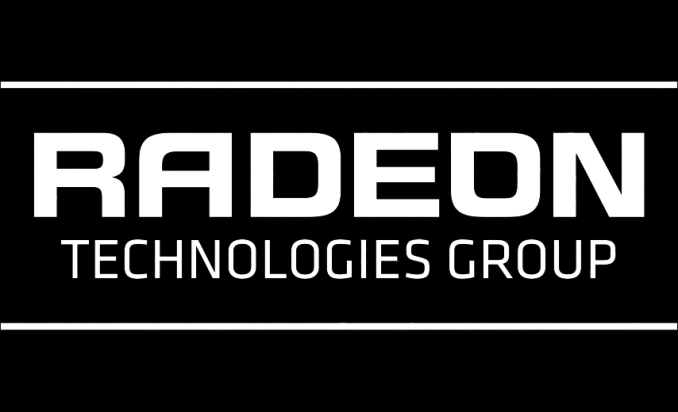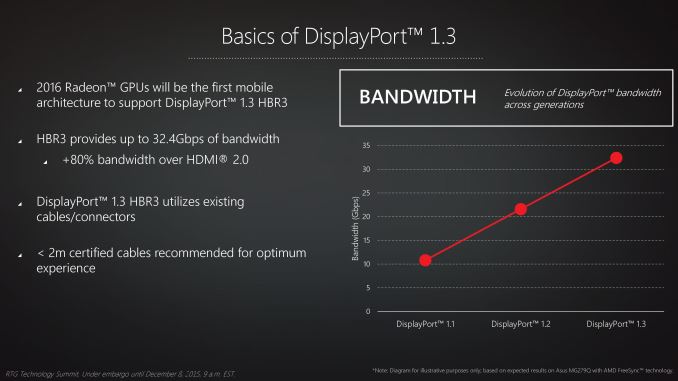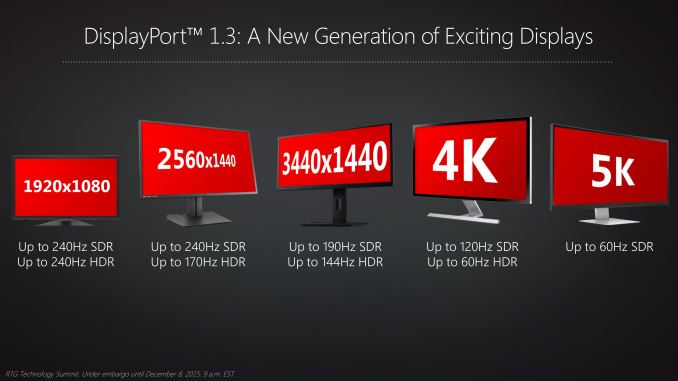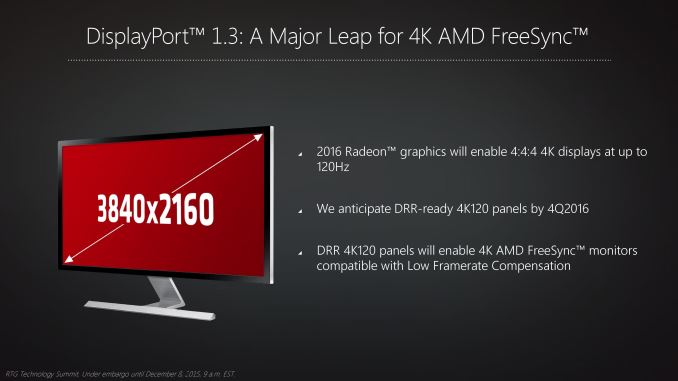AMD Discusses 2016 Radeon Visual Technologies Roadmap
by Ryan Smith on December 8, 2015 9:00 AM EST- Posted in
- GPUs
- Displays
- AMD
- Radeon
- DisplayPort
- HDMI
- Radeon Technologies Group

This is something that initially caught me off-guard when I first realized it, but AMD historically hasn’t liked to talk about their GPU plans much in advance. On the CPU size we’ve heard about Carrizo and Zen years in advance. Meanwhile AMD’s competitor in the world of GPUs, NVIDIA, releases some basic architectural information over a year in advance as well. However with AMD’s GPU technology, we typically don’t hear about it until the first products implementing new technology are launched.
With AMD’s GPU assets having been reorganized under the Radeon Technologies Group (RTG) and led by Raja Koduri, RTG has recognized this as well. As a result, the new RTG is looking to chart a bit of a different course, to be a bit more transparent and a bit more forthcoming than they have in the past. The end result isn’t quite like what AMD has done with their CPU division or their competition has done with GPU architectures – RTG will talk about both more or less depending on the subject – but among several major shifts in appearance, development, and branding we’ve seen since the formation of the RTG, this is another way in which RTG is trying to set itself apart from AMD’s earlier GPU groups.
As part of AMD’s RTG technology summit, I had the chance to sit down and hear about RTG’s plans for their visual technologies (displays) group for 2016. Though RTG isn’t announcing any new architecture or chips at this time, the company has put together a roadmap for what they want to do with both hardware and software for the rest of 2015 and in to 2016. Much of what follows isn’t likely to surprise regular observers of the GPU world, but it none the less sets some clear expectations for what is in RTG’s future over much of the next year.
DisplayPort 1.3 & HDMI 2.0a: Support Coming In 2016
First and foremost then, let’s start with RTG’s hardware plans. As I mentioned before RTG isn’t announcing any new architectures, but they are announcing some of the features that the 2016 Radeon GPUs will support. Among these changes is a new display controller block, upgrading the display I/O functionality we’ve seen as the cornerstone of AMD’s GPU designs since GCN 1.1 was first launched in 2013.
The first addition here is that RTG’s 2016 GPUs will be including support for DisplayPort 1.3. We’ve covered the announcement of DisplayPort 1.3 separately in the past, where in 2014 the VESA announced the release of the 1.3 standard. DisplayPort 1.3 will introduce a faster signaling mode for DisplayPort – High Bit Rate 3 (HBR3) – which in turn will allow DisplayPort 1.3 to offer 50% more bandwidth than the current DisplayPort 1.2 and HBR2, boosting DisplayPort’s bandwidth to 32.4 Gbps before overhead.
| DisplayPort Supported Resolutions | |||||||||||
| Standard | Max Resolution (RGB/4:4:4, 60Hz) |
Max Resolution (4:2:0, 60Hz) |
|||||||||
| DisplayPort 1.1 (HBR1) | 2560x1600 | N/A | |||||||||
| DisplayPort 1.2 (HBR2) | 3840x2160 | N/A | |||||||||
| DisplayPort 1.3 (HBR3) | 5120x2880 | 7680x4320 | |||||||||
The purpose of DisplayPort 1.3 is to offer the additional bandwidth necessary to support higher resolution and higher refresh rate monitors than the 4K@60Hz limit of DP1.2. This includes supporting higher refresh rate 4K monitors (120Hz), 5K@60Hz monitors, and 4K@60Hz with higher color depths than 8 bit per channel color (necessary for a good HDR implementation). DisplayPort’s scalability via tiling has meant that some monitor configurations have been possible even via DP1.2 by utilizing MST over multiple cables, however with DP1.3 it will now be possible to support those configurations in a simpler SST configuration over a single cable.
For RTG this is important on several levels. The first is very much pride – the company has always been the first GPU vendor to implement new DisplayPort standards. But at the same time DP1.3 is the cornerstone of multiple other efforts for the company. The additional bandwidth is necessary for the company’s HDR plans, and it’s also necessary to support the wider range of refresh rates at 4K necessary for RTG’s Freesync Low Framerate Compensation tech, which requires a 2.5x min:max ratio to function. That in turn has meant that while RTG has been able to apply LFC to 1080p and 1440p monitors today, they won’t be able to do so with 4K monitors until DP1.3 gives them the bandwidth necessary to support 75Hz+ operation.
Meanwhile DisplayPort 1.3 isn’t the only I/O standard planned for RTG’s 2016 GPUs. Also scheduled for 2016 is support for the HDMI 2.0a standard, the latest generation HDMI standard. HDMI 2.0 was launched in 2013 as an update to the HDMI standard, significantly increasing HDMI’s bandwidth to support 4Kp60 TVs, bringing it roughly on par with DisplayPort 1.2 in terms of total bandwidth. Along with the increase in bandwidth, HDMI 2.0/2.0a also introduced support for other new features in the HDMI specification such as the next-generation BT.2020 color space, 4:2:0 chroma sampling, and HDR video.
That HDMI has only recently caught up to DisplayPort 1.2 in bandwidth at a time when DisplayPort 1.3 is right around the corner is one of those consistent oddities in how the two standards are developed, but none the less this important for RTG. HDMI is not only the outright standard for TVs, but it’s the de facto standard for PC monitors as well; while you can find DisplayPort in many monitors, you would be hard pressed not to find HDMI. So as 4K monitors become increasingly cheap – and likely start dropping DisplayPort in the process – supporting HDMI 2.0 will be important for RTG for monitors just as much as it is for TVs.
Unfortunately for RTG, they’re playing a bit of catch-up here, as the HDMI 2.0 standard is already more than 2 years old and has been supported by NVIDIA since the Maxwell 2 architecture in 2014. Though they didn’t go into detail, I was told that AMD/RTG’s plans for HDMI 2.0 support were impacted by the cancelation of the company’s 20nm planar GPUs, and as a result HDMI 2.0 support was pushed back to the company’s 2016 GPUs. The one bit of good news here for RTG is that HDMI 2.0 is still a bit of a mess – not all HDMI 2.0 TVs actually support 4Kp60 with full chroma sampling (4:4:4) – but that is quickly changing.














99 Comments
View All Comments
wiak - Tuesday, December 8, 2015 - link
" an important development especially given the fact that DisplayPort support is non-existent on consumer AMD laptops."all laptops these days have eDP aka Embedded DisplayPort to the display panel"... :P
BurntMyBacon - Thursday, December 10, 2015 - link
@wiak: "all laptops these days have eDP aka Embedded DisplayPort to the display panel... :P"I think they were talking external ports. Though that still raises the question of why there aren't more adaptive sync laptops available as it shouldn't be that hard to implement.
Blitzvogel - Tuesday, December 8, 2015 - link
Nice to see AMD supporting new display tech as usual, especially the push for Freesync on both DP and HDMI, but some updates on the actual GPU architecture would've been nice too!A5 - Tuesday, December 8, 2015 - link
I've seen some HDR video content and it is the real deal. Very excited to see it come to the home video space soon...maybe in a decade we'll get HDR TV shows :-pAgent_007 - Tuesday, December 8, 2015 - link
"to directly support the HDCP 2.2 standard, which is being required for all 4K/HDR content"This claim is presented in multiple 4k video related articles, but it is incorrect. e.g. Netflix and Ultra HD Blu-ray may require HDCP 2.2 support for 4K/HDR, but you can e.g. download Big Buck Bunny in 4K60 and watch it without HDCP 2.2, or download Life of Pi – 4K UHD HDR.
That also means that those Gaming & Photos parts in the image are incorrect.
Murloc - Tuesday, December 8, 2015 - link
I think it's implied that they're talking about traditional and paying home cinema customers, who will be using UHD blu-rays and netflix.Mr Perfect - Tuesday, December 8, 2015 - link
If RTG is talking, ask them about motion blur compensation! As much as I'd like to use an open standard like Freesync/Adaptivesync, the Low Motion Blur compensation in GSync is really tempting, especially for FPS games. I'd love to see some feature parity between AMD and Nvidia here.Jon Irenicus - Tuesday, December 8, 2015 - link
The only sad part of this presentation is that it looks like we will have to wait much longer to get a holy grail display / port.Displayport 1.3 has enough bandwidth for 4k @ 120Hz, but apparently NOT enough to ALSO include HDR.
The dream computer display tops out from 40-43" in size to keep a similar ppi @4k as the current 27" displays @1440p
is
oled
4k
vrr range of 35Hz - 120Hz
low input latency
HDR - and here is the rub, displayport 1.3 can't give all of this at once. Disappointed.
Beany2013 - Tuesday, December 8, 2015 - link
Are there even any games that you can play at 4k/120hz that can be driven to that level by the current generation (or upcoming) of GPUs, full stop?You're not wrong, but I don't think we're there yet, are we?
Jon Irenicus - Tuesday, December 8, 2015 - link
Not the latest games, no. This is more about next years gpus though, the first die shrink in several years, we can almost sort of push 4K @ 60fps with certain settings turned down on top end cards, but next year we should be able to more reliably go above 60fps on top end single gpu solutions, and there we want to have 4k displays that go beyond 60fps.... it's a pity we can't get HDR too. Though to be honest, unless it's an oled I don't even want an HDR display, what's the point without the deep blacks. And local dimming is not good enough.